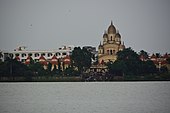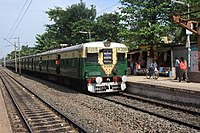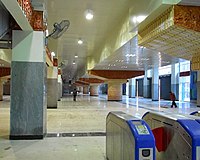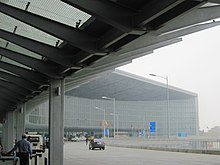North 24 Parganas District
History
Pre-independence
The territory of Greater 24 Parganas were under the Satgaon (ancient Saptagram, now in Hoogly district) administration during the Mughal era and later it was included in Hoogly chakla (district under post-Mughal Nawabi rule) during the rule of Murshid Quli Khan. In 1757, after the Battle of Plassey, Nawab Mir Jafar conferred the Zamindari of 24 parganas and janglimahals (small administrative units) upon the British East India Company. These Parganas are: 1. Akbarpur, 2. Amirpur, 3. Asimabad, 4. Balia, 5. Baridhati, 6. Basandhari, 7. Birati, 8. Kolkata, 9. Dakshin Sagar, 10. Garh, 11. Hathiagarh, 12. Ikhtiarpur, 13. Kharijuri, 14. Khaspur, 15. Maidanmal or Mednimall, 16. Magura, 17. Mayda, 18. Manpur, 19. Murnagacha, 20. Paika, 21. Pechakul, 22. Satal, 23. Shahnagar, 24. Shahpur, and 25. Uttar Pargana (O'Mally, L.S.S. (1914) Bengal District Gazetteers: 24 Parganas. Page 44). Since then, this entire territory is known as '24 Parganas'.
In 1751, the Company assigned John Zephaniah Holwell as zemindar of the District. In 1759, after the Bengali War of 1756–1757, the Company assigned it to Lord Clive as a personal Jaghir (zamindari) and after his death it again came under the direct authority of the company.
In 1793, during the rule of Lord Cornwallis, entire Sunderbans were in Twentyfour Parganas. In 1802, some parganas on the western banks of river Hoogly were included into it. These parganas were in Nadia earlier. In 1814, a separate collectorate was established in Twenty-four Parganas. In 1817, Falta and Baranagar and in 1820, some portions of Nadia's Balanda and Anwarpur were encompassed to it. In 1824, portions of Barasat, Khulna and Bakhargunge (now in Bangladesh) were also included to it. In 1824, the district headquarters was shifted from Kolkata to Baruipur, but in 1828, it was removed to Alipore. In 1834, the district was split into two districts – Alipore and Barasat, but later these were united again.
In 1905, some portion of this district around the Sunderbans was detached and linked to Khulna and Barishal. These parts remained in Bangladesh territories where Jashore’s Bangaon was joined to Twentyfour Pargana after the 1947 partition.
After Independence
In 1980, an administrative reform committee under the chairmanship of Dr. Ashok Mitra suggested splitting the district into two and as per the recommendation of the committee in 1983, on 1 March 1986, two new districts – North 24 Parganas (24 PGS (N)) and South 24 Parganas (24 PGS (S)) were created. The North 24 Parganas which was included in the Presidency division has been formed with five sub-divisions of the Greater 24 Parganas, namely Barasat Sadar (Headquarters), Barrackpore, Basirhat, Bangaon, and Bidhannagar (a satellite township of Kolkata, popularly known as Salt Lake).
On 1 August 2022, the Chief Minister of West Bengal Mamata Banerjee announced to create two more districts named Ichamati district consisting of Bangaon subdivision and a yet unnamed district consisting of Basirhat subdivision by bifurcating the district for better development and smooth administration purpose.
Geography
The district lies within the Ganga–Brahmaputra delta. The major distributary of river Ganga that is river Hooghly flows along the western border of the district. There are many other distributary branches, sub-branches of Ganga river and other local rivers, which include the Ichhamati, Jamuna, and Bidyadhari.
Economy
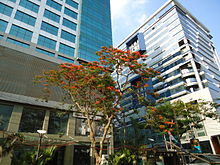


People are mainly engaged in farming, fishing and other agricultural activities. The average size of agricultural landholdings is about 3.2 Bighas. North 24 Parganas is one of the economically developed districts of West Bengal, but there is chronic poverty in the southern half of the district (the Sundarbans area).
The information technology hub of Kolkata is at this district, which is the centre of some of the notable IT/ITES Indian and multinational companies. Approximately 1,500 companies have their offices in Sector V. Majority of the corporate offices are situated in Sector V and Sector III. Around 3.5 Lakh (by 2017) people are employed in Salt Lake City.
Divisions
Administrative subdivisions

The district comprises five subdivisions: Barrackpore, Barasat Sadar, Basirhat, Bangaon and Bidhannagar.
- Barrackpore Subdivision consists of 16 municipalities (Kanchrapara, Halisahar, Naihati, Bhatpara, Garulia, Barrackpore, North Barrackpur, New Barrackpur, Titagarh, Khardaha, Panihati, Kamarhati, Baranagar, Dum Dum, North Dumdum and South Dumdum (25 Wards)) and 2 community development blocks: Barrackpore I and Barrackpore II.
- Barasat Sadar Subdivision consists of five municipalities (Barasat, Habra, Ashoknagar Kalyangarh, Madhyamgram, and Gobardanga) and 7 community development blocks: Barasat I, Barasat II, Amdanga, Deganga, Habra I and Habra II
- Bongaon Subdivision, consists of Bangaon municipality and three community development blocks: Bagdah, Bangaon and Gaighata.
- Basirhat Subdivision consists of three municipalities (Basirhat, Baduria and Taki) and ten community development blocks: Baduria, Basirhat I, Basirhat II, Haroa, Hasnabad, Hingalganj, Minakhan, Sandeshkhali I, Sandeshkhali II, Swarupnagar.
- Bidhannagar Subdivision consists of Bidhannagar Municipal Corporation, South Dum Dum Municipality (10 wards) and one community development blocks Rajarhat.
Barasat is the district headquarters. There are 35 police stations, 22 development blocks, 27 municipalities, 200 gram panchayats and 1599 villages in this district.
Other than municipality area, each subdivision contains community development blocks which in turn are divided into rural areas and census towns. In total there are 48 urban units: 27 municipalities and 20 census towns and 1 cantonment board.
- 16 municipalities: Kanchrapara, Halisahar, Naihati, Bhatpara, Garulia, Barrackpore, North Barrackpur, New Barrackpur, Titagarh, Khardaha, Panihati, Kamarhati, Baranagar, Dum Dum, North Dumdum and South Dumdum.
- One Cantonment Board: Barrackpur Cantonment.
- One more census town: Ichhapur Defence Estate.
- Barrackpore I (Community development block) consists of rural areas with 8 gram panchayats and three census towns: Jetia, Garshyamnagar and Kaugachhi.
- Barrackpore II (Community development block) consists of rural areas with 6 gram panchayats and six census towns: Jafarpur, Talbandha, Muragachha, Patulia, Ruiya and Chandpur.
- Panchayet: Duttapukur
- 5 municipalities: Barasat, Habra, Ashoknagar Kalyangarh, Madhyamgram and Gobardanga.
- Barasat I (Community development block) consists of rural areas with 9 gram panchayats and 1 census town: Duttapukur.
- Barasat II (Community development block) consists of rural areas only with 7 gram panchayats.
- Amdanga (Community development block) consists of rural areas only with 8 gram panchayats.
- Deganga (Community development block) consists of rural areas only with 13 gram panchayats.
- Habra I (Community development block) consists of rural areas with 7 gram panchayats and 3 census towns: Nokpul, Maslandapur and Sadpur.
- Habra II (Community development block) consists of rural areas with 8 gram panchayats and 2 census towns: Bara Bamonia and Guma.
- Rajarhat (Community development block) (now shifted to Bidhannagar Subdivision) consists of rural areas with 6 gram panchayats (after Mahishbathan II gram panchayat being shifted to Bidhannagar Municipal Corporation, number of gram panchayats becomes 5) and 1 census town: Raigachhi.
- 1 municipality: Bangaon.
- Bagdah (Community development block) consists of rural areas only with 9 gram panchayats.
- Bangaon (Community development block) consists of rural areas only with 16 gram panchayats.
- Gaighata (Community development block) consists of rural areas with 13 gram panchayats and seven census towns: Chandpara(7,113), Chhekati (4,995), Sonatikiri (6,919), Dhakuria (10,165), Chikanpara (9,594), Shimulpur (20,803) and Bara (5,172).
- Three municipalities: Basirhat, Baduria and Taki.
- Baduria (Community development block) consists of rural areas only with 14 gram panchayats.
- Basirhat I (Community development block) consists of rural areas only with 7 gram panchayats.
- Basirhat II (Community development block) consists of rural areas with 9 gram panchayats and one census town: Dhanyakuria.
- Haroa (Community development block) consists of rural areas only with 8 gram panchayats.
- Hasnabad (Community development block) consists of rural areas only with 9 gram panchayats.
- Hingalganj (Community development block) consists of rural areas only with 9 gram panchayats.
- Minakhan (Community development block) consists of rural areas only with 8 gram panchayats.
- Sandeshkhali I (Community development block) consists of rural areas only with 8 gram panchayats.
- Sandeshkhali II (Community development block) consists of rural areas only with 8 gram panchayats.
- Swarupnagar (Community development block) consists of rural areas only with 10 gram panchayats.
This subdivision consists of the Bidhannagar Municipal Corporation.
- Rajarhat (Community development block) is also shifted to this subdivision now.
Assembly constituencies
As per order of the Delimitation Commission in respect of the delimitation of constituencies in the West Bengal, the district is divided into 33 assembly constituencies:
- Bagdah, Bangaon Uttar and Dakshin, Gaighata, Swarupnagar, Minakhan and Hingalganj constituencies are reserved for Scheduled Castes (SC) candidates while Sandeshkhali is reserved for Schedule Tribe (ST).
- Bagdaha, Bangaon Uttar and Dakshin, Gaighata, Swarupnagar, and Kalyani and Haringhata (two assembly constituencies from Nadia) assembly constituencies form the Bangaon (Lok Sabha constituency) which is reserved for Schedule Caste (SC) candidate.
- Habra, Ashoknagar, Rajarhat-New Town, Bidhannagar, Madhyagram, Barasat, Deganga assembly constituencies form the Barasat (Lok Sabha constituency).
- Khardaha, Dum Dum, Dum Dum Uttar, Panihati, Kamarhati, Baranagar, Rajarhat Gopalpur assembly constituencies form the Dum Dum (Lok Sabha constituency).
- Amdanga, Bijpur, Naihati, Bhatpara, Jagatdal, Noapara, Barrackpore assembly constituencies form the Barrackpore (Lok Sabha constituency).
- Baduria, Haroa, Minakhan, Sandeshkhali, Basirhat Uttar, Basirhat Dakshin, Hingalganj constituencies are part of the Basirhat (Lok Sabha constituency).


